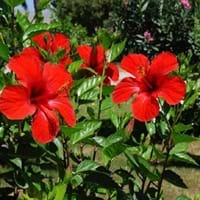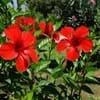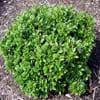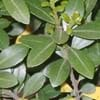Life Span
Annual and Perennial
Annual and Perennial
Type
Broadleaf Evergreen
Bulb or Corm or Tuber
Origin
China
Central America, South America
Types
Not Available
Vine, Flowering plant
Habitat
gardens, Grassland, Homesteads, Subtropical climates, tropical environments
All sorts of environments, Along Railroads, Banks, Moist Ditches, Roadsides, rocky banks of streams
USDA Hardiness Zone
9-15
10-13
AHS Heat Zone
Not Available
12-1
Habit
Oval or Rounded
Vining/Climbing
Minimum Width
Not Available
Flower Color
Yellow, Red, Dark Red
Purple, Rose
Flower Color Modifier
Bicolor
Bicolor
Fruit Color
Not Available
Not Available
Leaf Color in Spring
Dark Green
Purple, Dark Green, Black
Leaf Color in Summer
Dark Green
Light Green
Leaf Color in Fall
Dark Green
Several shades of Green
Leaf Color in Winter
Dark Green
Light Green
Leaf Shape
Ovate
Acicular
Plant Season
Spring, Summer, Fall, Winter
Spring, Summer, Fall, Winter
Sunlight
Full Sun, Partial Sun
Full Sun, Partial Sun
Growth Rate
Medium
Very Fast
Type of Soil
Loam
Clay, Loam, Sand
The pH of Soil
Neutral
Acidic, Neutral, Alkaline
Soil Drainage
Well drained
Well drained
Bloom Time
Early Summer, Summer, Late Summer, Early Fall, Fall, Indeterminate
Late Spring, Early Summer, Summer, Late Summer, Early Fall, Fall, Late Fall
Tolerances
Drought, Variety of soil types
Drought
Where to Plant?
Ground, Pot
Container, Ground
How to Plant?
Stem Cutting, Tip cutting, Vegetative Reproduction
Cuttings, Leaf Cutting, Tuber propagation
Plant Maintenance
Medium
Medium
Watering Requirements
It cannot sustain wet-feet, Keep the Soil well drained, Requires watering in the growing season, Water Deeply, Water frequently while growing, Water more in summer, Water when soil is dry
Keep the Soil well drained, Needs very little water
In Summer
Lots of watering
Lots of watering
In Spring
Moderate
Moderate
In Winter
Average Water
Average Water
Soil pH
Neutral
Acidic, Neutral, Alkaline
Soil Type
Loam
Clay, Loam, Sand
Soil Drainage Capacity
Well drained
Well drained
Sun Exposure
Full Sun, Partial Sun
Full Sun, Partial Sun
Pruning
A hard prune may be necessary if the plant becomes woody, Cut leaves after fall, Cut or pinch the stems, Pinch or prune as they grow to promote branching and bushiness, Prune for shortening long shoots, Prune in early summer, Remove deadheads
Remove damaged leaves, Remove dead branches, Remove dead leaves
Fertilizers
Apply 10-10-10 amount, Balanced liquid fertilizer, Do not fertilize new plants until at least a month, Use a low phosphate fertilizer to improve the quality of the blooms
All-Purpose Liquid Fertilizer
Pests and Diseases
Aphids, Mealybugs, Red spider mite, Scale, Thripes, Whiteflies
Red blotch
Plant Tolerance
Drought, Variety of soil types
Drought
Flower Petal Number
Single
Single
Foliage Texture
Medium
Coarse
Foliage Sheen
Glossy
Matte
Attracts
Bees, Butterflies, Hummingbirds
Aphids, Beetles, Cutworms, Insects, Mites, Whiteflies
Allergy
no allergic reactions
Abdominal pain, allergic reaction, Nausea, Skin rash, Twitching of face
Aesthetic Uses
Beautification, Borders, Landscape Designing
Not Used For Aesthetic Purpose
Beauty Benefits
Hair Conditioner, Not Available, Prevents greying of hair, Prevents Premature Baldness, Promotes Healthy Hair, Promotes healthy skin, Speed hair growth
Not Available
Environmental Uses
Air purification
Air purification
Medicinal Uses
anti-inflammatory, Diuretic, Hair Loss, High blood pressure, Vitamin C
Cures constipation, Fiber, Low calories, lowering blood pressure, Potassium, ß-carotene, Vitamin A, Vitamin C
Part of Plant Used
Flowers, Leaf Stalks, Leaves
Leaves, Root, Shoots, Stem, Tuber
Other Uses
Culinary use, Employed in herbal medicine, Jam, Jelly, Making Shampoo, Oil is used for aromatherapy, Oil is used in perfume, soaps, creams, etc., Showy Purposes, Traditional medicine, Use in Chinese herbology, Used As Food, Used as Ornamental plant, Used for bedding in gardens, Used for fragrance, Used for its medicinal properties, Used in making beverages, Used in paper industry, Used in salads, Used to make hair tonic
Starch, Used As Food, Used as Ornamental plant
Used As Indoor Plant
No
Sometimes
Used As Outdoor Plant
Yes
Yes
Garden Design
Container, Foundation, Houseplant, Mixed Border, Tropical
Container, Edible, Groundcover, Hanging Basket, Herb / Vegetable, Mixed Border, Rock Garden / Wall, Vine
Botanical Name
HIBISCUS rosa-sinensis 'Lillikoi Yellow'
IPOMOEA batatas 'Blackie'
Common Name
China rose
Blackie Sweet Potato Vine, Sweet Potato Vine
In Hindi
गुड़हल, जवा कुसुम
शकरकन्द
In German
Tropical Hibiscus
Süßkartoffel
In French
Hibiscus Tropical
Patate douce
In Spanish
hibisco tropical
Ipomoea batatas
In Greek
τροπική Hibiscus
Sweet potato
In Portuguese
Hibiscus tropical
Batata-doce
In Polish
Tropical Hibiscus
Wilec ziemniaczany
In Latin
Tropical Hibiscus
Ipomoea batatas
Phylum
Magnoliophyta
Tracheophyta
Class
Magnoliopsida
Magnoliopsida
Family
Malvaceae
Convolvulaceae
Clade
Angiosperms, Eudicots, Rosids
Angiosperms, Asterids, Eudicots
Tribe
Hibisceae
Not Available
Subfamily
Malvoideae
Not Available
Number of Species
Not Available
Importance of Chinese hibiscus and Sweet Potato Vine
Want to have the most appropriate plant for your garden? You might want to know the importance of Chinese hibiscus and Sweet Potato Vine. Basically, these two plants vary in many aspects. Compare Chinese hibiscus and Sweet Potato Vine as they differ in many characteristics such as their life, care, benefits, facts, etc. Every gardener must at least have the slightest clue about the plants he wants to plant in his garden. Compare their benefits, which differ in many ways like facts and uses. The medicinal use of Chinese hibiscus is anti-inflammatory, Diuretic, Hair Loss, High blood pressure and Vitamin C whereas of Sweet Potato Vine is Cures constipation, Fiber, Low calories, lowering blood pressure, Potassium, ß-carotene, Vitamin A and Vitamin C. Chinese hibiscus has beauty benefits as follows: Hair Conditioner, Not Available, Prevents greying of hair, Prevents Premature Baldness, Promotes Healthy Hair, Promotes healthy skin and Speed hair growth while Sweet Potato Vine has beauty benefits as follows: Hair Conditioner, Not Available, Prevents greying of hair, Prevents Premature Baldness, Promotes Healthy Hair, Promotes healthy skin and Speed hair growth.
Compare Facts of Chinese hibiscus vs Sweet Potato Vine
How to choose the best garden plant for your garden depending upon its facts? Here garden plant comparison will help you to solve this query. Compare the facts of Chinese hibiscus vs Sweet Potato Vine and know which one to choose. As garden plants have benefits and other uses, allergy is also a major drawback of plants for some people. Allergic reactions of Chinese hibiscus are no allergic reactions whereas of Sweet Potato Vine have Abdominal pain, allergic reaction, Nausea, Skin rash and Twitching of face respectively. Having a fruit bearing plant in your garden can be a plus point of your garden. Chinese hibiscus has no showy fruits and Sweet Potato Vine has no showy fruits. Also Chinese hibiscus is not flowering and Sweet Potato Vine is not flowering . You can compare Chinese hibiscus and Sweet Potato Vine facts and facts of other plants too.





